Abstract
To assess the adaptive value of the right-shift of the oxyhemoglobin dissociation curve (decreased affinity for oxygen) observed in humans upon altitude exposure, the short-term physiologic responses to altitude-induced hypoxia were evaluated in two subjects with a high oxygen affinity hemoglobin (Hb Andrew-Minneapolis) and in two of their normal siblings. In striking contrast to normal subjects, at moderately high altitude (3,100 m) the high affinity subjects manifested: (a) lesser increments in resting heart rate; (b) minimal increases in plasma and urinary erythropoietin; (c) no decrement in maximal oxygen consumption; and (d) no thrombocytopenia. There was no difference between subject pairs in 2,3-diphosphoglycerate response to altitude exposure. These results tend to contradict the belief that a decrease in hemoglobin oxygen affinity is of adaptive value to humans at moderate altitudes. Rather, they support the hypothesis that, despite disadvantages at low altitude, a left-shifted oxyhemoglobin dissociation curve may confer a degree of preadaptation to altitude.
Full text
PDF

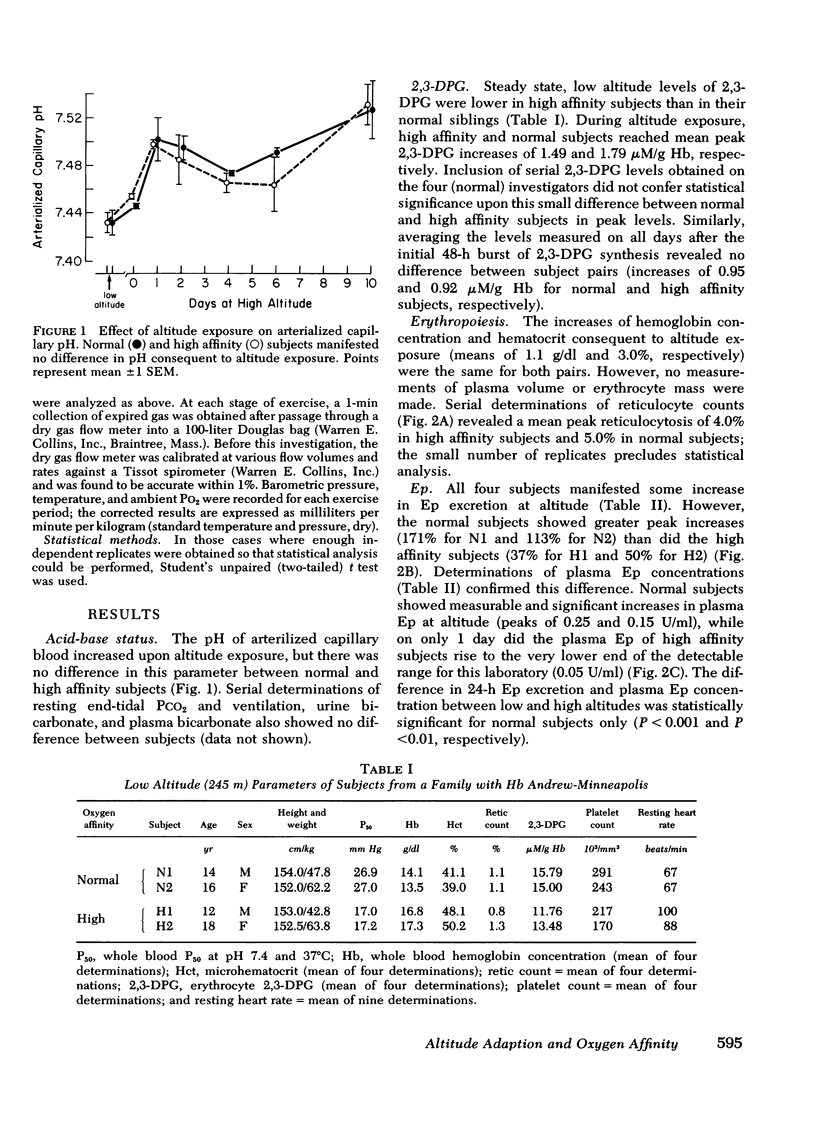
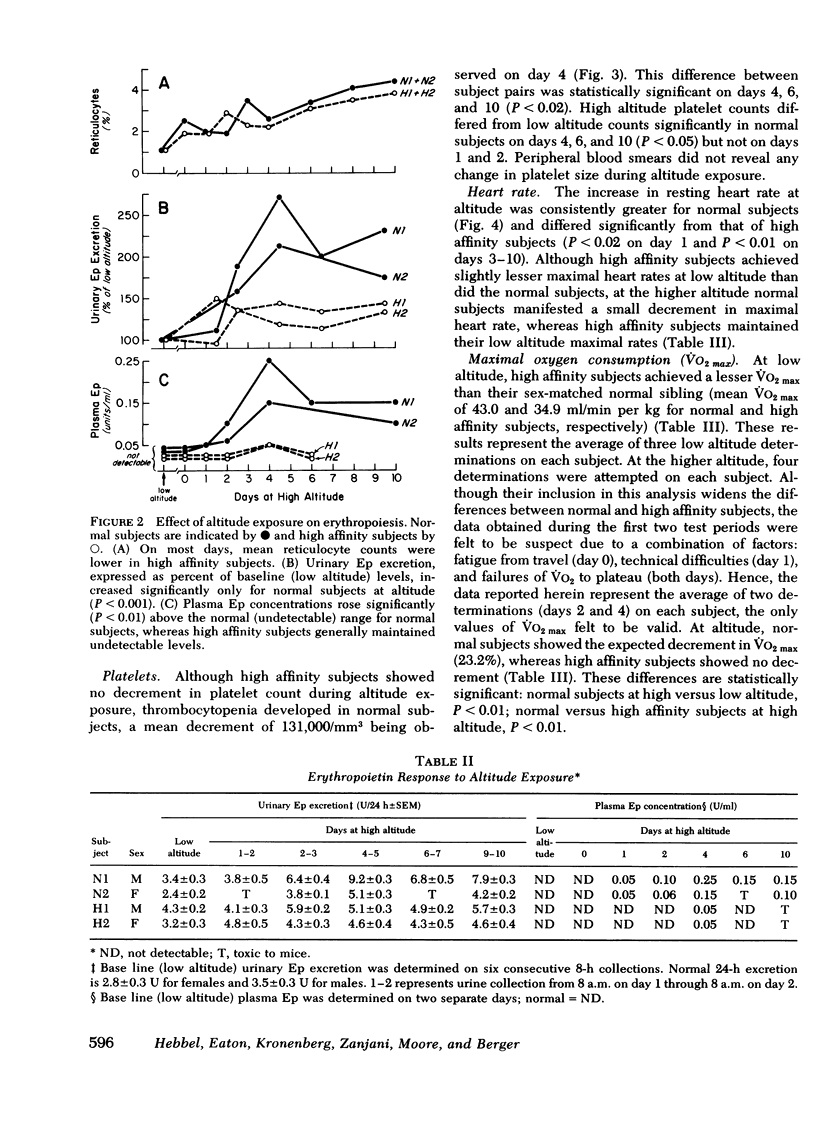
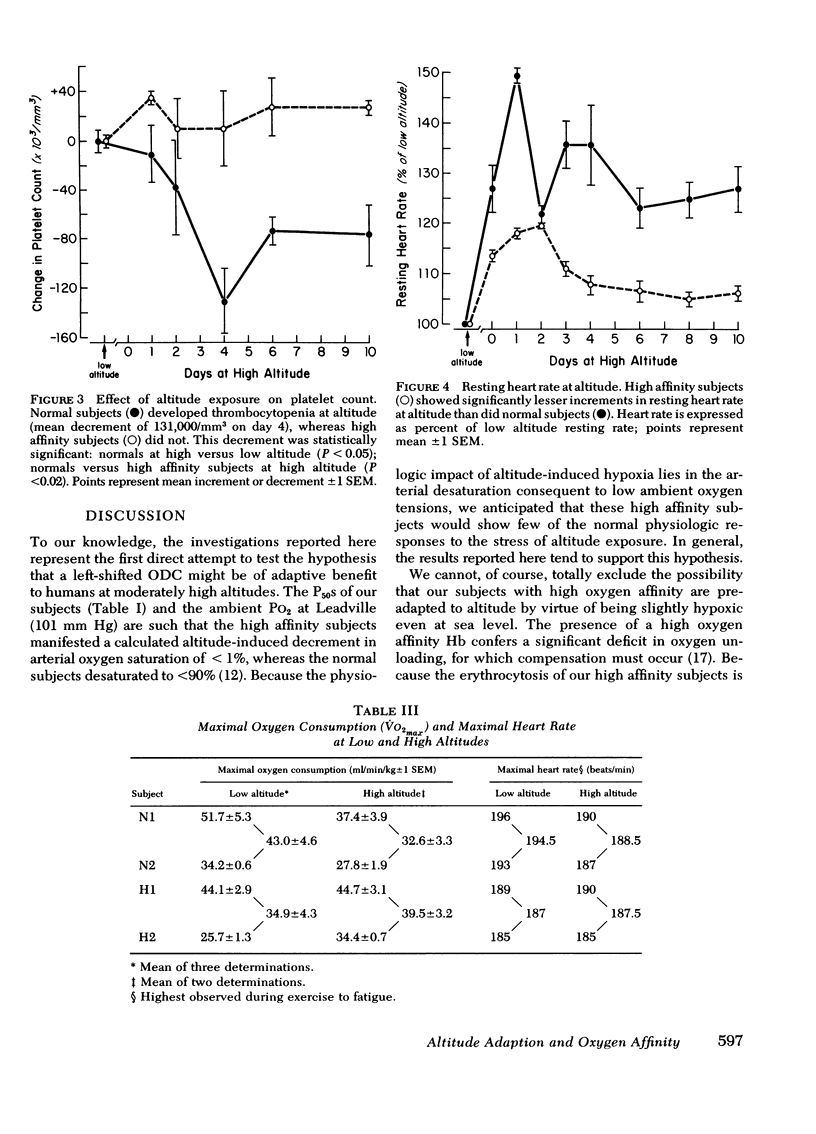
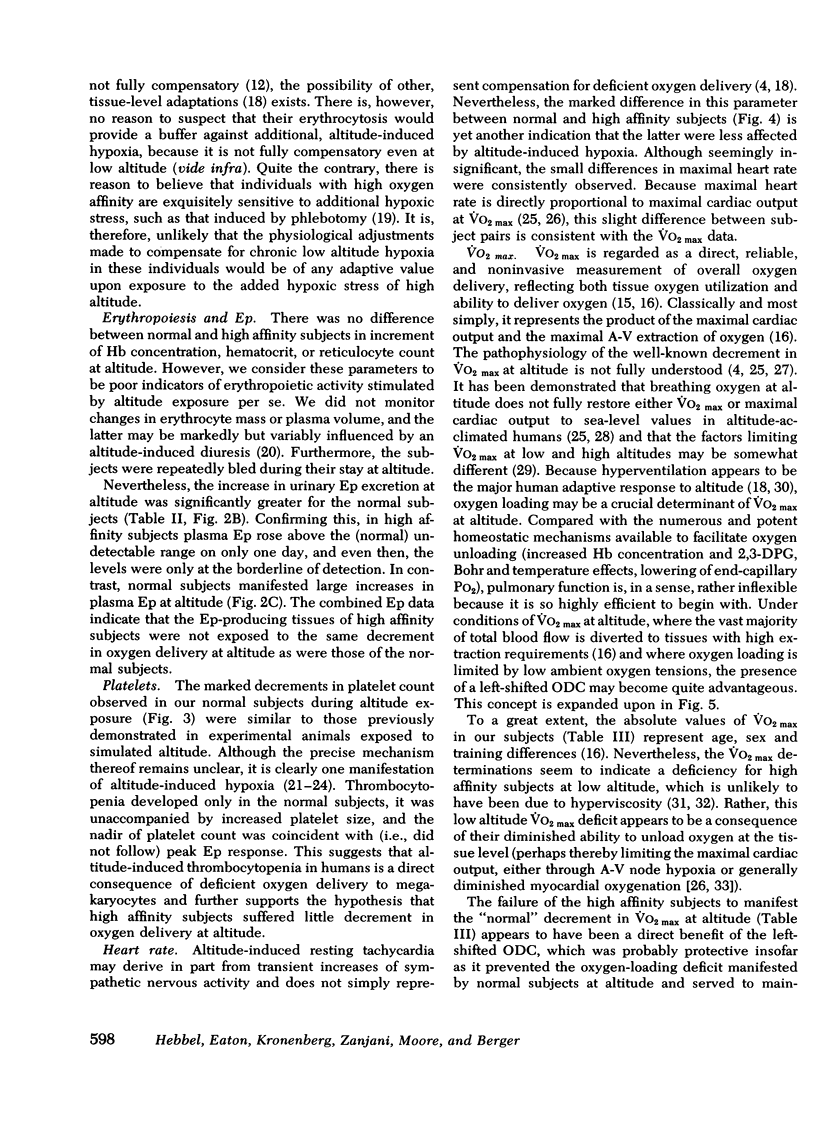
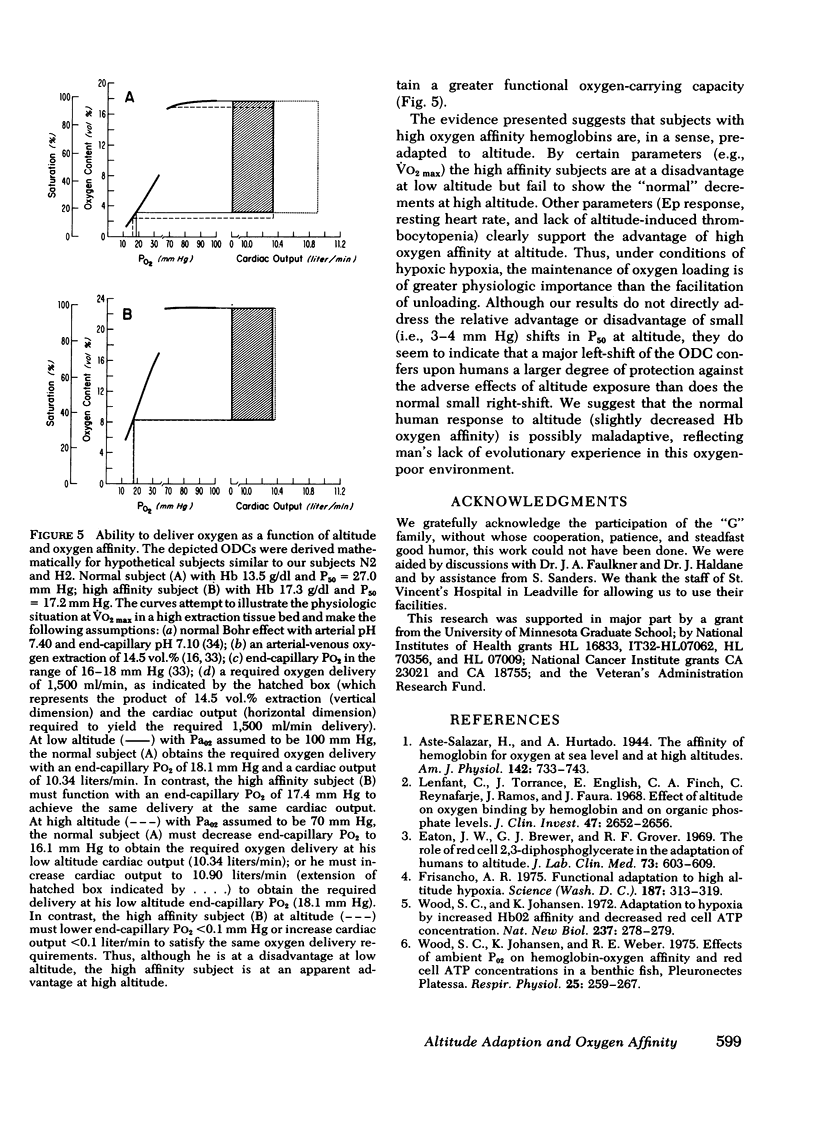
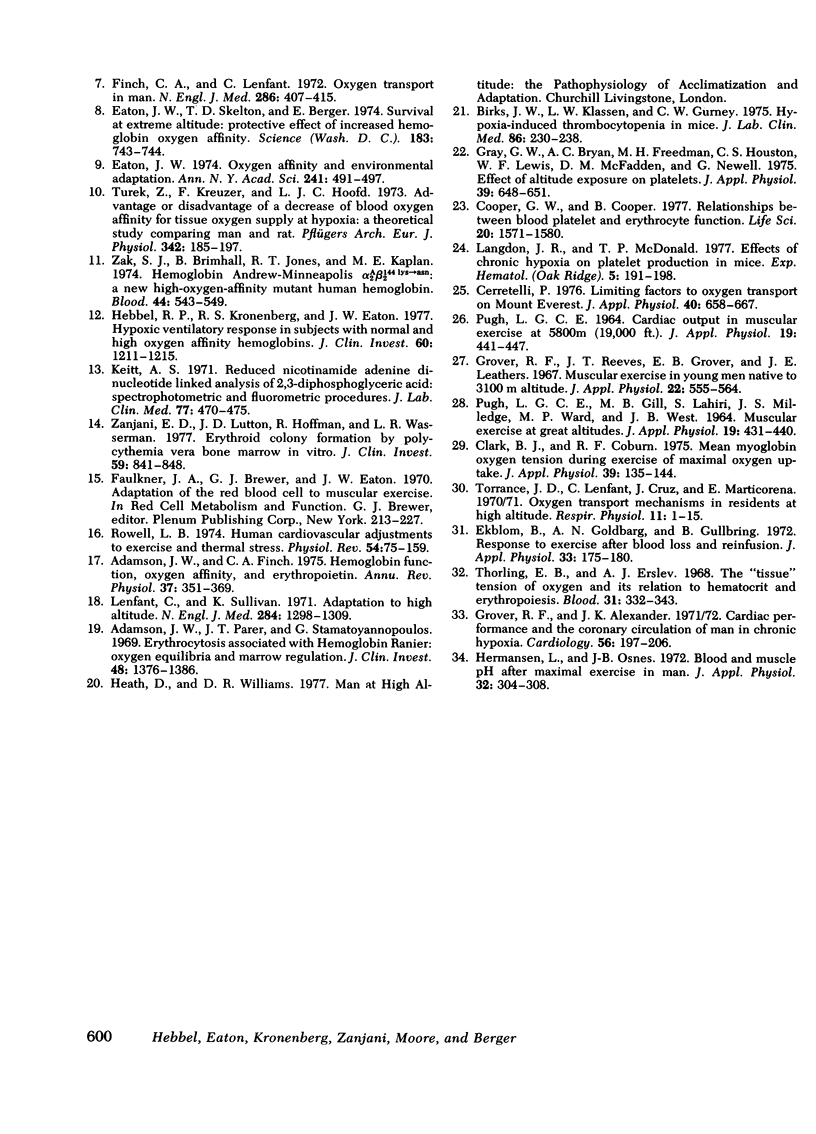
Selected References
These references are in PubMed. This may not be the complete list of references from this article.
- Adamson J. W., Finch C. A. Hemoglobin function, oxygen affinity, and erythropoietin. Annu Rev Physiol. 1975;37:351–369. doi: 10.1146/annurev.ph.37.030175.002031. [DOI] [PubMed] [Google Scholar]
- Adamson J. W., Parer J. T., Stamatoyannopoulos G. Erythrocytosis associated with hemoglobin Rainier: oxygen equilibria and marrow regulation. J Clin Invest. 1969 Aug;48(8):1376–1386. doi: 10.1172/JCI106103. [DOI] [PMC free article] [PubMed] [Google Scholar]
- Birks J. W., Klassen L. W., Gurney C. W. Hypoxia-induced thrombocytopenia in mice. J Lab Clin Med. 1975 Aug;86(2):230–238. [PubMed] [Google Scholar]
- Cerretelli P. Limiting factors to oxygen transport on Mount Everest. J Appl Physiol. 1976 May;40(5):658–667. doi: 10.1152/jappl.1976.40.5.658. [DOI] [PubMed] [Google Scholar]
- Clark B. J., Coburn R. F. Mean myoglobin oxygen tension during exercise at maximal oxygen uptake. J Appl Physiol. 1975 Jul;39(1):135–144. doi: 10.1152/jappl.1975.39.1.135. [DOI] [PubMed] [Google Scholar]
- Cooper G. W., Cooper B. Relationships between blood platelet and erythrocyte formation. Life Sci. 1977 May 1;20(9):1571–1579. doi: 10.1016/0024-3205(77)90450-7. [DOI] [PubMed] [Google Scholar]
- Eaton J. W., Brewer G. J., Grover R. F. Role of red cell 2,3-diphosphoglycerate in the adaptation of man to altitude. J Lab Clin Med. 1969 Apr;73(4):603–609. [PubMed] [Google Scholar]
- Eaton J. W. Oxygen affinity and environmental adaptation. Ann N Y Acad Sci. 1974 Nov 29;241(0):491–497. doi: 10.1111/j.1749-6632.1974.tb21905.x. [DOI] [PubMed] [Google Scholar]
- Eaton J. W., Skelton T. D., Berger E. Survival at extreme altitude: protective effect of increased hemoglobin-oxygen affinity. Science. 1974 Feb 22;183(4126):743–744. doi: 10.1126/science.183.4126.743. [DOI] [PubMed] [Google Scholar]
- Ekblom B., Goldbarg A. N., Gullbring B. Response to exercise after blood loss and reinfusion. J Appl Physiol. 1972 Aug;33(2):175–180. doi: 10.1152/jappl.1972.33.2.175. [DOI] [PubMed] [Google Scholar]
- Finch C. A., Lenfant C. Oxygen transport in man. N Engl J Med. 1972 Feb 24;286(8):407–415. doi: 10.1056/NEJM197202242860806. [DOI] [PubMed] [Google Scholar]
- Frisancho A. R. Functional adaptation to high altitude hypoxia. Science. 1975 Jan 31;187(4174):313–319. doi: 10.1126/science.1089311. [DOI] [PubMed] [Google Scholar]
- Gray G. W., Bryan A. C., Freedman M. H., Houston C. S., Lewis W. F., McFadden D. M., Newell G. Effect of altitude exposure on platelets. J Appl Physiol. 1975 Oct;39(4):648–652. doi: 10.1152/jappl.1975.39.4.648. [DOI] [PubMed] [Google Scholar]
- Grover R. F., Alexander J. K. Cardiac performance and the coronary circulation of main in chronic hypoxia. Cardiology. 1971;56(1):197–206. doi: 10.1159/000169361. [DOI] [PubMed] [Google Scholar]
- Grover R. F., Reeves J. T., Grover E. B., Leathers J. E. Muscular exercise in young men native to 3,100 m altitude. J Appl Physiol. 1967 Mar;22(3):555–564. doi: 10.1152/jappl.1967.22.3.555. [DOI] [PubMed] [Google Scholar]
- Hebbel R. P., Kronenberg R. S., Eaton J. W. Hypoxic ventilatory response in subjects with normal and high oxygen affinity hemoglobins. J Clin Invest. 1977 Nov;60(5):1211–1215. doi: 10.1172/JCI108874. [DOI] [PMC free article] [PubMed] [Google Scholar]
- Hermansen L., Osnes J. B. Blood and muscle pH after maximal exercise in man. J Appl Physiol. 1972 Mar;32(3):304–308. doi: 10.1152/jappl.1972.32.3.304. [DOI] [PubMed] [Google Scholar]
- Keitt A. S. Reduced nicotinamide adenine dinucleotide-linked analysis of 2,3-diphosphoglyceric acid: spectrophotometric and fluorometric procedures. J Lab Clin Med. 1971 Mar;77(3):470–475. [PubMed] [Google Scholar]
- Langdon J. R., McDonald T. P. Effects of chronic hypoxia on platelet production in mice. Exp Hematol. 1977 May;5(3):191–198. [PubMed] [Google Scholar]
- Lenfant C., Sullivan K. Adaptation to high altitude. N Engl J Med. 1971 Jun 10;284(23):1298–1309. doi: 10.1056/NEJM197106102842305. [DOI] [PubMed] [Google Scholar]
- Lenfant C., Torrance J., English E., Finch C. A., Reynafarje C., Ramos J., Faura J. Effect of altitude on oxygen binding by hemoglobin and on organic phosphate levels. J Clin Invest. 1968 Dec;47(12):2652–2656. doi: 10.1172/JCI105948. [DOI] [PMC free article] [PubMed] [Google Scholar]
- PUGH L. G., GILL M. B., LAHIRI S., MILLEDGE J. S., WARD M. P., WEST J. B. MUSCULAR EXERCISE AT GREAT ALTITUDES. J Appl Physiol. 1964 May;19:431–440. doi: 10.1152/jappl.1964.19.3.431. [DOI] [PubMed] [Google Scholar]
- Rowell L. B. Human cardiovascular adjustments to exercise and thermal stress. Physiol Rev. 1974 Jan;54(1):75–159. doi: 10.1152/physrev.1974.54.1.75. [DOI] [PubMed] [Google Scholar]
- Thorling E. B., Erslev A. J. The "tissue" tension of oxygen and its relation to hematocrit and erythropoiesis. Blood. 1968 Mar;31(3):332–343. [PubMed] [Google Scholar]
- Torrance J. D., Lenfant C., Cruz J., Marticorena E. Oxygen transport mechanisms in residents at high altitude. Respir Physiol. 1970;11(1):1–15. doi: 10.1016/0034-5687(70)90098-8. [DOI] [PubMed] [Google Scholar]
- Turek Z., Kreuzer F., Hoofd L. J. Advantage or disadvantage of a decrease of blood oxygen affinity for tissue oxygen supply at hypoxia. A theoretical study comparing man and rat. Pflugers Arch. 1973 Aug 27;342(3):185–197. doi: 10.1007/BF00591367. [DOI] [PubMed] [Google Scholar]
- Wood S. C., Johansen K. Adaptation to hypoxia by increased HbO 2 affinity and decreased red cell ATP concentration. Nat New Biol. 1972 Jun 28;237(78):278–279. doi: 10.1038/newbio237278a0. [DOI] [PubMed] [Google Scholar]
- Wood S. C., Johansen K., Weber R. E. Effects of ambient PO2 on hemoglobin-oxygen affinity and red cell ATP concentrations in a benthic fish, Pleuronectes platessa. Respir Physiol. 1975 Dec;25(3):259–267. doi: 10.1016/0034-5687(75)90002-x. [DOI] [PubMed] [Google Scholar]
- Zak S. J., Brimhall B., Jones R. T., Kaplan M. E. Hemoglobin Andrew-Minneapolis alpha 2 A beta 2 144 Lys leads to Asn: a new high-oxygen-affinity mutant human hemoglobin. Blood. 1974 Oct;44(4):543–549. [PubMed] [Google Scholar]
- Zanjani E. D., Lutton J. D., Hoffman R., Wasserman L. R. Erythroid colony formation by polycythemia vera bone marrow in vitro. Dependence on erythropoietin. J Clin Invest. 1977 May;59(5):841–848. doi: 10.1172/JCI108706. [DOI] [PMC free article] [PubMed] [Google Scholar]


